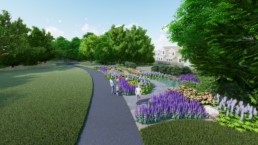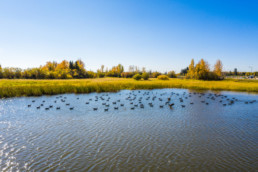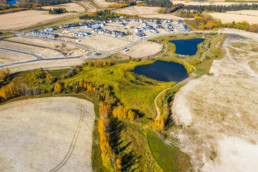Honouring History in Dave Larratt Park
Dave Larratt acquired the property, now known as Evergreen, in the 1940’s. He conducted a mixed farming operation in the area and pastured cattle on these lands. With the objective of securing a reliable water supply for his cattle, Dave installed a couple of dams in the 1950s. Over the years, a wetland/natural area formed that was close to 10 acres in size. This area attracted a wide variety of wildlife including deer, moose, fox, coyote, muskrat, beaver, waterfowl, and migratory birds. Additionally, it has supported an interesting assortment of plant life.
Dave Larratt passed away suddenly in March, 1964 and the agricultural operation continued under lease arrangements with other farmers in the area. Dave’s son, Larry, took over ownership of the land in 1975 and maintained the family’s stewardship of the natural area. Many times over the years he was encouraged to remove the dams to return the drainage course to its original function and increase the farmable area. Consequently, Larry’s reluctance to change what his father built has aided in the area’s success over the years and has been enjoyed by four generations of his family.
In 2012, Melcor purchased the land from Mr. Larry Larratt and began planning the Evergreen neighbourhood. It was imperative that Evergreen pay homage to the Larratt family by preserving the 30+ acre area and making it the heart of the new community.
In 2014, honouring Dave Larratt and in recognition of his contributions to the natural area, Melcor made an application to have the area formally named Dave Larratt Park, and received approval from the City of Red Deer’s Municipal Features Naming Committee.
Dave Larratt Park will be enhanced with public amenities designed to encourage responsible and low impact interactions with nature. Furthermore, it will serve in perpetuity as a public open space of municipal and environmental reserve providing many ecological & recreational functions for the benefit of the broader community.
Read on to see our plans for such amenities and how they play on the natural beauty and history of the land.
Multi-Use Trail Network
An extensive trail network and park system will be developed for the benefit of not only the residents of Evergreen but for all of north east Red Deer.
A portion of the network contains a 650m loop which has already been constructed, while another 900m with be complete in 2021. When finished, there will be nearly 3km of trail meandering around different sections of Dave Larratt Park and providing connections to future neighbourhoods outside of Evergreen.
Natural Pond – South Pond
The southern pond is a pre-existing wetland that has been preserved. A high-level outlet has been installed to create a maximum water level and protect the homes and surrounding infrastructure. Natural overland drainage courses into this pond have been maintained to preserve a healthy wetland. A request has been made to the City of Red Deer to allow skating on this natural pond in winter months as is allowed on some other ponds in Red Deer that do not serve as Storm Water Management Facilities.
Edible Forest
Edible plants, such as pears, saskatoon berries, gooseberries, wild black currant, and haskap honeyberries, will be planted in a concentrated area of Dave Larratt Park in 2021.
Constructed Wetland (Storm Water Management Facility) – North Pond
Stormwater is managed through underground pipes and street gutters; these eventually lead to the Red Deer River. Rainwater is channeled to this constructed wetland collecting in the pond before re-entering the stormwater system. The volume of water becomes manageable in the system as it is released back into the storm sewer at a slower rate.
The wetland serves a second purpose, removing significant amounts of sediment and contaminants from the water before it is returned to the river. A deep entry point in the pond helps sediment to settle there, and the cattails and other aquatic plants absorb contaminants washed in with the stormwater. These plants also make the area more attractive and provide an important habitat for mammals, birds, and invertebrates.
The constructed wetland portion of Dave Larratt Park was completed in 2019.
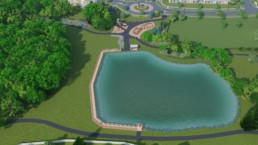
Nature Inspired Playgrounds
Two nature inspired playgrounds have been designed in the central portion of Dave Larratt Park just west of the Natural Pond and will be constructed in 2021. The playgrounds are designed with accessible surfacing and accommodate all ages. A third playground will be designed in the future to be located on the east side of the ponds.

Waterfall & Bridge Feature
A waterfall and bridge feature has been constructed at the south end of the constructed wetland that acts as a gathering area and seating node to relax and take in the sights and sounds of Dave Larratt Park.
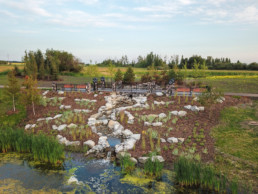
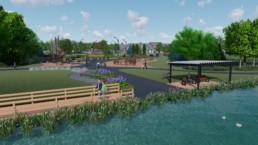
Boardwalk
A boardwalk will be along the edge of the south pond will be constructed in 2021/2022. Boardwalks are used as a low-impact alternative to traditional trail systems as they have minimal environmental impact allowing park users to interact with nature in a responsible manner.
Pollinator Garden
A pollinator garden will be planted in 2021 providing a habitat for native pollinators. A pollinator is an insect or animal that moves pollen (the yellow powder in flowers) from one flower to another. This pollen exchange is needed to produce seeds and fruit. Over 1,000 varieties of plants that we depend on for food, medicine, and fibre, need pollinators to reproduce.
